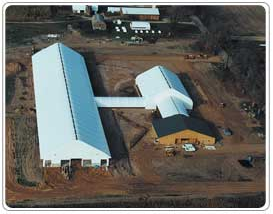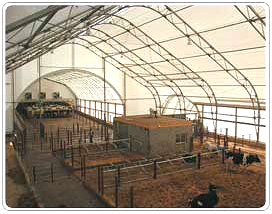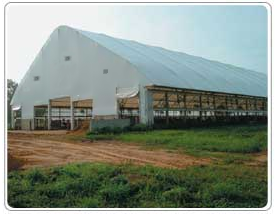Hood Dairy Farms
|
Location:
Paw Paw, Michigan Building Size: 100' W x 460' L, 90' W x 120' L, 50' W x 80' L, 30' W x 96' L Application: Dairy Operation |
Fabric Covered Buildings Ideal for Dairy Expansion |
|
Hood Dairy Farms 100' W x 460' L free-stall barn attached to a 30' W x 96' L crosswalk. Hood Dairy Farms is a four-generation family farm that expanded its dairy operation from 50 cows to 400 cows in 2000. For many generations, dairy and cash crops were the main business, but consistently low grain prices drove the need to change. After years of planning and research to grow the herd and use the land efficiently, Hood Farms chose a fabric structure for their dairy operation. Before we made our decision, we visited another large fabric building dairy facility in Wisconsin and we were totally impressed,"¯ says Tim Hood. "When I walked into their barn I thought to myself, If I were a cow, this is the barn I would want to be in. The long-term goal is to expand the dairy operation to 800 cows and have the facilities and cow management systems to accommodate this growth strategy. Superior air ventilation and clearspan design of the fabric covered buildings were also important features to Hood Farms. "Because the roof is so much higher than a conventional barn, we have a large volume of air over the cattle. We were able to design the barn to get all the natural ventilation we need. The air always smells good in our barns. "We are a family dairy operation, so we need the fabric buildings to last generations. The materials that fabric buildings are constructed with are far superior to anything else" - Tim Hood
The Hood family has four fabric covered steel truss buildings. All four fabric buildings are connected to guarantee maximum cow comfort. The 100' wide x 460' long main free stall is attached to a 30' wide x 96' long cross-walk which leads to a 90' wide x 120' long barn for close up cows. The close-up cow area is connected to a 50' wide x 80' long fabric building holding area and milking parlor. "We are a family dairy operation, so we need the buildings to last generations, says Hood. "The materials that fabric buildings are constructed with are far superior to anything else. Metal buildings are prone to rust and the treated posts in wood barns can rot. Fabric buildings utilize galvanized steel with a triple-coated corrosion barrier for the interior frame system. The fabric cover is resistant to rust and virtually maintenance free. The four fabric buildings were installed in just three weeks, preventing any rain delays for contractors to finish pouring the cement floor. |
|
All these benefits add up to a more productive environment for cows and dairy operators. "When you purchase animals from a number of different sources, health issues can be a concern, says Hood. "We are confident that the combination of fresh air, natural light and good cow management are the reasons for excellent herd health. I'm pleased to say that we have maintained exceptional health of our herd during the transition period. Fabric buildings have proven to be the ideal dairy barn solution for the business and provisions for another 100' wide x 460' long fabric building are already in the plans for the next phase of expansion.
"We are confident that the combination of fresh air, natural light and good cow management are the reasons for excellent herd health," says Tim Hood.
The 90' W x 120' L barn for close-up cows is connected to the 50' W x 80' L holding area.
"We were able to design the barn to get all the natural ventilation we need," says Tim Hood. |




